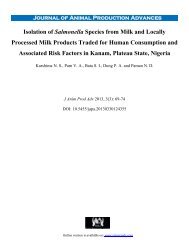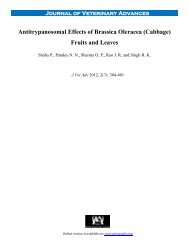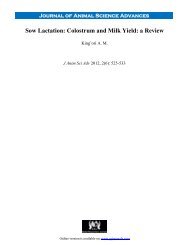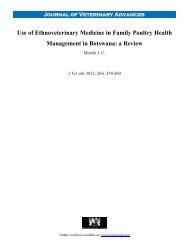Effect of Storage Time on Hatchability of Guinea Fowl Eggs
Effect of Storage Time on Hatchability of Guinea Fowl Eggs
Effect of Storage Time on Hatchability of Guinea Fowl Eggs
Create successful ePaper yourself
Turn your PDF publications into a flip-book with our unique Google optimized e-Paper software.
Journal <str<strong>on</strong>g>of</str<strong>on</strong>g> Animal Science Advances<br />
<str<strong>on</strong>g>Effect</str<strong>on</strong>g> <str<strong>on</strong>g>of</str<strong>on</strong>g> <str<strong>on</strong>g>Storage</str<strong>on</strong>g> <str<strong>on</strong>g>Time</str<strong>on</strong>g> <strong>on</strong> <strong>Hatchability</strong> <str<strong>on</strong>g>of</str<strong>on</strong>g> <strong>Guinea</strong> <strong>Fowl</strong> <strong>Eggs</strong><br />
Moreki J. C. and Ditshupo T.<br />
J Anim Sci Adv 2012, 2(7): 631-636<br />
Online versi<strong>on</strong> is available <strong>on</strong>: www.grjournals.com
ISSN: 2251-7219<br />
MOREKI AND DITSHUPO<br />
<str<strong>on</strong>g>Effect</str<strong>on</strong>g> <str<strong>on</strong>g>of</str<strong>on</strong>g> <str<strong>on</strong>g>Storage</str<strong>on</strong>g> <str<strong>on</strong>g>Time</str<strong>on</strong>g> <strong>on</strong> <strong>Hatchability</strong> <str<strong>on</strong>g>of</str<strong>on</strong>g> <strong>Guinea</strong><br />
<strong>Fowl</strong> <strong>Eggs</strong><br />
Original Article<br />
Moreki J. C. and Ditshupo T.<br />
Department <str<strong>on</strong>g>of</str<strong>on</strong>g> Animal Science and Producti<strong>on</strong>, Botswana College <str<strong>on</strong>g>of</str<strong>on</strong>g> Agriculture, Private Bag 0027, Gabor<strong>on</strong>e, Botswana<br />
Abstract<br />
A study was c<strong>on</strong>ducted to determine the effects <str<strong>on</strong>g>of</str<strong>on</strong>g> length <str<strong>on</strong>g>of</str<strong>on</strong>g> storage time <strong>on</strong> hatchability <str<strong>on</strong>g>of</str<strong>on</strong>g> guinea fowl<br />
eggs. A total <str<strong>on</strong>g>of</str<strong>on</strong>g> 125 eggs were obtained from the <strong>on</strong>going guinea fowl project and used in this study. <strong>Eggs</strong> were<br />
divided into five batches with each batch comprising 25 eggs. Following collecti<strong>on</strong>, all eggs were individually<br />
weighed using electr<strong>on</strong>ic scale and stored in a cool room at 20 o C for different storage times <str<strong>on</strong>g>of</str<strong>on</strong>g> 0, 4, 7, 10 and<br />
14 days. Prior to setting, eggs were weighed again and thereafter set in the incubator at 37 o C and 70% relative<br />
humidity. Data from five batches <str<strong>on</strong>g>of</str<strong>on</strong>g> eggs were analyzed using General Linear Model (GLM) <str<strong>on</strong>g>of</str<strong>on</strong>g> Statistical<br />
Analysis S<str<strong>on</strong>g>of</str<strong>on</strong>g>tware (versi<strong>on</strong> 9.2) to determine the effect <str<strong>on</strong>g>of</str<strong>on</strong>g> storage time <strong>on</strong> hatchability <str<strong>on</strong>g>of</str<strong>on</strong>g> guinea fowl eggs. A<br />
significant difference in hatchability am<strong>on</strong>g different batches <str<strong>on</strong>g>of</str<strong>on</strong>g> eggs was found. The results <str<strong>on</strong>g>of</str<strong>on</strong>g> the present<br />
study showed that storage time significantly (P
Introducti<strong>on</strong><br />
<strong>Guinea</strong> fowl breeders produce thicker shelled<br />
eggs in comparis<strong>on</strong> to that <str<strong>on</strong>g>of</str<strong>on</strong>g> a regular chicken. An<br />
egg’s shell makes up 15% <str<strong>on</strong>g>of</str<strong>on</strong>g> the total weight <str<strong>on</strong>g>of</str<strong>on</strong>g> the<br />
egg which is 9% <str<strong>on</strong>g>of</str<strong>on</strong>g> that <str<strong>on</strong>g>of</str<strong>on</strong>g> a regular chicken<br />
(Yildirim, 2012). Hatching eggs are not usually<br />
incubated immediately after lay but are stored at<br />
both hatcheries and breeder farms, as the latter are<br />
usually located a c<strong>on</strong>siderable distance from the<br />
hatchery (Schmidt et al., 2009). When hatching<br />
eggs have accumulated, they are stored at the<br />
hatchery until sufficient incubator space is<br />
available. Furthermore, if the number <str<strong>on</strong>g>of</str<strong>on</strong>g> eggs is<br />
limited they may be stored l<strong>on</strong>ger in the hatchery<br />
until there are enough to fill large incubator racks.<br />
Therefore, egg handling prior to incubati<strong>on</strong> is <str<strong>on</strong>g>of</str<strong>on</strong>g><br />
utmost importance.<br />
In order to limit the development <str<strong>on</strong>g>of</str<strong>on</strong>g> the<br />
embryo, hatching eggs should be stored at 13 to<br />
18.3 °C at 75% relative humidity (Whitehead et al.,<br />
2002), 13 to 18 °C (Fasenko, 2008) and 15 to 18 o C<br />
with a relative humidity <str<strong>on</strong>g>of</str<strong>on</strong>g> about 75% (Hamre,<br />
2008). According to Hamre (2008), chicken eggs<br />
should be incubated within 7 to 10 days after they<br />
are laid as hatchability declines rapidly when<br />
incubati<strong>on</strong> is postp<strong>on</strong>ed for more than 10 days. For<br />
Carole (2009), the optimum storage time for guinea<br />
fowl eggs is seven days. Egg storage for over seven<br />
days increases embry<strong>on</strong>ic death and chick poultry<br />
quality. Whitehead et al. (2002) stated that the<br />
period which eggs are stored before hatching affects<br />
the incubati<strong>on</strong> success. Prol<strong>on</strong>ged storage <str<strong>on</strong>g>of</str<strong>on</strong>g> eggs <str<strong>on</strong>g>of</str<strong>on</strong>g><br />
poultry species decreases egg quality, increases<br />
embry<strong>on</strong>ic mortality, and extend incubati<strong>on</strong> time.<br />
The authors recommended that eggs should be<br />
stored for not l<strong>on</strong>ger than seven days.<br />
As guinea fowl farming is in its infancy in<br />
Botswana, informati<strong>on</strong> <strong>on</strong> storage <str<strong>on</strong>g>of</str<strong>on</strong>g> guinea fowl<br />
eggs prior to incubati<strong>on</strong> is limited. Therefore, a<br />
study was c<strong>on</strong>ducted to investigate the effect <str<strong>on</strong>g>of</str<strong>on</strong>g> egg<br />
storage time <strong>on</strong> hatchability <str<strong>on</strong>g>of</str<strong>on</strong>g> guinea fowl eggs.<br />
Material and Methods<br />
Bird management and egg collecti<strong>on</strong><br />
<strong>Guinea</strong> fowl (males and females) were housed<br />
in <strong>on</strong>e pen and fed layers mash. Feed and water<br />
EFFECT OF STORAGE TIME ON HATCHABILITY OF …<br />
were given ad libitum (Szczerbińska et al., 2004). A<br />
total <str<strong>on</strong>g>of</str<strong>on</strong>g> 125 eggs were obtained from Botswana<br />
College <str<strong>on</strong>g>of</str<strong>on</strong>g> Agriculture guinea fowl unit and<br />
subjected to five storage periods, i.e.; 0, 4, 7, 10 and<br />
14 days before incubati<strong>on</strong>. Data collecti<strong>on</strong> took 15<br />
days to complete i.e.; 1 to 15 February 2012. The<br />
parameters studied were hatchability, mortality,<br />
deformity, peeps (live) and clears.<br />
Egg collecti<strong>on</strong><br />
<strong>Eggs</strong> were collected in the morning at 1000 hr.<br />
in c<strong>on</strong>tainers which were cushi<strong>on</strong>ed to avoid<br />
shaking <str<strong>on</strong>g>of</str<strong>on</strong>g> the eggs (Hassan et al., 2005). <strong>Eggs</strong> were<br />
divided into 5 batches with each batch having 25<br />
eggs. Following lay, eggs were individually<br />
weighed with a precisi<strong>on</strong> scale (0.01 g precisi<strong>on</strong>)<br />
(Hassan et al., 2005; Romao et al. 2008). Dirty eggs<br />
were discarded during egg collecti<strong>on</strong>. Each egg was<br />
individually marked with a unique identifier<br />
(pencil) before storage.<br />
Egg management and incubati<strong>on</strong><br />
Prior to setting, eggs were stored for 0, 4, 7, 10<br />
and 14 days with the broad end up in the cool room<br />
at 20 o C. All eggs were individually weighed and<br />
set in the incubator at 37 o C and relative humidity <str<strong>on</strong>g>of</str<strong>on</strong>g><br />
70 % (Lourens et al., 2005; Hassan et al., 2005).<br />
Each batch <str<strong>on</strong>g>of</str<strong>on</strong>g> eggs was separated from each other<br />
so that there was no mixing <str<strong>on</strong>g>of</str<strong>on</strong>g> eggs <str<strong>on</strong>g>of</str<strong>on</strong>g> different<br />
batches in the incubator. Unhatched eggs were<br />
broken and dead in shells (DIS), peeps, and clear<br />
(infertile eggs) recorded. Weak and leg deformed<br />
keets were also recorded. Percentage mortality <str<strong>on</strong>g>of</str<strong>on</strong>g><br />
keets for each batch was calculated as total dead<br />
keets divided by total keets hatched and then<br />
multiplied by 100 (Nwagu, 1997). <strong>Hatchability</strong> was<br />
calculated as total eggs hatched divided by total<br />
eggs set and then multiplied by 100.<br />
Statistical Analysis<br />
General Lineal Model (GLM) <str<strong>on</strong>g>of</str<strong>on</strong>g> SAS (versi<strong>on</strong><br />
9.2) (SAS Institute, 2000-2008) was used to<br />
determine the effects <str<strong>on</strong>g>of</str<strong>on</strong>g> storage time <strong>on</strong> hatchability<br />
<str<strong>on</strong>g>of</str<strong>on</strong>g> guinea fowl eggs. Treatment means were<br />
separated using Tukey studentised range (HSD)<br />
test.<br />
Results and Discussi<strong>on</strong><br />
632 J. Anim. Sci. Adv., 2012, 2(7):631-636
MOREKI AND DITSHUPO<br />
<strong>Hatchability</strong><br />
The effect <str<strong>on</strong>g>of</str<strong>on</strong>g> storage time <strong>on</strong> hatchability <str<strong>on</strong>g>of</str<strong>on</strong>g><br />
guinea fowl eggs is illustrated in Fig. 1. As shown<br />
in Fig. 1, hatchability declined with increased<br />
storage time. <strong>Hatchability</strong> decreased with increased<br />
storage time from 0 to 14 days. This result is<br />
c<strong>on</strong>sistent with Schmidt et al. (2009) who reported<br />
that storing eggs from 5 to 10 days reduces<br />
hatchability. Also, Petek and Dikmen (2006),<br />
Romao et al. (2008) and Schmidt et al. (2009)<br />
reported that l<strong>on</strong>g storage <str<strong>on</strong>g>of</str<strong>on</strong>g> eggs reduces<br />
hatchability, increases incubati<strong>on</strong> time and<br />
decreases egg weight and egg fertility. Similarly,<br />
Demirel and Kırıkçı (2009) found a negative effect<br />
<str<strong>on</strong>g>of</str<strong>on</strong>g> storage time <strong>on</strong> hatchability <str<strong>on</strong>g>of</str<strong>on</strong>g> pheasant eggs. On<br />
the c<strong>on</strong>trary, Cağlayan et al. (2009) found that l<strong>on</strong>g<br />
storage periods do not have negative effects <strong>on</strong><br />
hatchability <str<strong>on</strong>g>of</str<strong>on</strong>g> partridge eggs.<br />
Fig. 1: The effect <str<strong>on</strong>g>of</str<strong>on</strong>g> storage time <strong>on</strong> hatchability <str<strong>on</strong>g>of</str<strong>on</strong>g> guinea fowl eggs.<br />
According to Fig. 1, the number <str<strong>on</strong>g>of</str<strong>on</strong>g> DIS and<br />
clears increased with storage time. The result <strong>on</strong><br />
DIS is in agreement with Romao et al. (2008) who<br />
found that increased storage time increases embryo<br />
mortality rate during storage and incubati<strong>on</strong>. In this<br />
study, no embryo mortality was observed from 0 to<br />
4 days indicating that embryo development was not<br />
affected by storage time. There was more DIS from<br />
10 to 14 days storage periods compared to other<br />
storage periods. No peeps were observed from 0 to<br />
4 days <str<strong>on</strong>g>of</str<strong>on</strong>g> egg storage. However, peeps increased<br />
from 4 to 7 days storage time and thereafter<br />
declined. The current results are also c<strong>on</strong>sistent with<br />
Petek and Dikmen (2006) and Romao et al. (2008)<br />
who found that l<strong>on</strong>g storage time prior to incubati<strong>on</strong><br />
decreased hatchability.<br />
Length <str<strong>on</strong>g>of</str<strong>on</strong>g> incubati<strong>on</strong><br />
The effect <str<strong>on</strong>g>of</str<strong>on</strong>g> storage time <strong>on</strong> incubati<strong>on</strong> time is<br />
shown in Table 1. According to Table 1, incubati<strong>on</strong><br />
time increased with length <str<strong>on</strong>g>of</str<strong>on</strong>g> storage time from 0 to<br />
14 days. Similar results were found by T<strong>on</strong>a et al.<br />
(2003) who suggested that l<strong>on</strong>ger storage prol<strong>on</strong>ged<br />
durati<strong>on</strong> <str<strong>on</strong>g>of</str<strong>on</strong>g> incubati<strong>on</strong>.<br />
As shown in Table 1, over two thirds (67.21%)<br />
<str<strong>on</strong>g>of</str<strong>on</strong>g> the keets that hatched came from eggs that were<br />
stored for 0 and 4 days. It is apparent that 85.25%<br />
<str<strong>on</strong>g>of</str<strong>on</strong>g> keets were hatched between 25 and 27 days <str<strong>on</strong>g>of</str<strong>on</strong>g><br />
incubati<strong>on</strong>. However, days 26 and 27 recorded the<br />
highest number (60.66%) <str<strong>on</strong>g>of</str<strong>on</strong>g> keets hatched. As<br />
shown in Table 1, storage time c<strong>on</strong>tributed to a<br />
decline in hatchability <str<strong>on</strong>g>of</str<strong>on</strong>g> guinea fowl eggs. These<br />
findings are in agreement with Whitehead et al.<br />
(2002) who reported that prol<strong>on</strong>ged storage <str<strong>on</strong>g>of</str<strong>on</strong>g> eggs<br />
<str<strong>on</strong>g>of</str<strong>on</strong>g> poultry species decreases egg quality, increases<br />
embry<strong>on</strong>ic mortality, and extends incubati<strong>on</strong> time.<br />
633 J. Anim. Sci. Adv., 2012, 2(7):631-636
EFFECT OF STORAGE TIME ON HATCHABILITY OF …<br />
In the present study, zero storage time c<strong>on</strong>tributed<br />
more keets (36.07%) than other storage periods.<br />
The study also dem<strong>on</strong>strated that increased<br />
storage time increased length <str<strong>on</strong>g>of</str<strong>on</strong>g> incubati<strong>on</strong>.<br />
<strong>Hatchability</strong> for 0, 4, 7, 10 and 14 days storage<br />
times was 88%, 76%, 40%, 36%, and 4%<br />
respectively. According to Table 1, incubati<strong>on</strong><br />
period ranged from 25 to 29 days. These results are<br />
inc<strong>on</strong>sistent with Majewska (2001) who indicated<br />
that the normal incubati<strong>on</strong> period for guinea fowl<br />
eggs ranges from 26 to 28 days.<br />
Egg weight<br />
Data <strong>on</strong> initial egg weight, egg weight at set<br />
time, egg weight at transfer, egg weight from set to<br />
transfer and egg weight loss percentage from set to<br />
transfer are presented in Table 2. As shown in Table<br />
2, initial egg weight for 0 and 4 days <str<strong>on</strong>g>of</str<strong>on</strong>g> storage<br />
time, was significantly (P0.05). According to<br />
Table 2, initial egg weight increased with storage<br />
time. The present results are c<strong>on</strong>sistent with<br />
Swiatkiewicz et al. (2010) and Bannette et al.<br />
(2004) who found that older birds produce larger<br />
eggs than young <strong>on</strong>es. In disagreement with current<br />
results, Tebesi et al. (2012) in Botswana reported<br />
that storage time had no effect <strong>on</strong> egg weight <str<strong>on</strong>g>of</str<strong>on</strong>g><br />
guinea fowl.<br />
Table 1: .<str<strong>on</strong>g>Effect</str<strong>on</strong>g> <str<strong>on</strong>g>of</str<strong>on</strong>g> storage time <strong>on</strong> incubati<strong>on</strong> process<br />
Spread <str<strong>on</strong>g>of</str<strong>on</strong>g> incubati<strong>on</strong><br />
<str<strong>on</strong>g>Storage</str<strong>on</strong>g> time (days)<br />
Day 25 Day 26 Day 27 Day 28 Total<br />
0 15 (60) 5 (20) 2 (8) 0 (0) 22(36.07)<br />
4 0 (0) 12 (48) 6 (24) 1(4) 19(31.15)<br />
7 0 (0) 1 (4) 4 (16) 5 (20) 10(16.39)<br />
10 0 (0) 0 (0) 6 (24) 3 (12) 9(14.75)<br />
14 0 (0) 0 (0) 1 (4) 0 (0) 1(1.64)<br />
Total 15(24.59) 18(29.51) 19(31.15) 9(14.75) 61(100)<br />
*Values in brackets are percentages<br />
Table 2: <str<strong>on</strong>g>Effect</str<strong>on</strong>g> <str<strong>on</strong>g>of</str<strong>on</strong>g> storage time <strong>on</strong> egg weight parameters<br />
Egg storage Egg weight Egg Egg weight Egg weight Significant SEM<br />
(days) initial weight set transfer loss (%)<br />
0 42.661 b 42.661 b 33.150 b 22.257 a * ±9.511<br />
4 45.797 a 45.652 a 38.233 a 16.342 c * ±7.418<br />
7 44.698 ab 43.667 ab 35.842 ab 18.132 bc ** ±7.825<br />
10 43.855 ab 42.500 b 34.024 b 20.291 ab ** ±8.476<br />
14 43.585 ab 41.686 b 34.221 b 17.936 bc ** ±7.465<br />
SEM = Standard error <str<strong>on</strong>g>of</str<strong>on</strong>g> mean.<br />
a-c within columns, values with different superscripts differ significantly (**P< 0.05;*P 0.05). On the other hand, egg<br />
weight at transfer for 0, 4 and 7 days <str<strong>on</strong>g>of</str<strong>on</strong>g> storage time<br />
was significantly (P
MOREKI AND DITSHUPO<br />
(Table 2). Higher (22.26%) and lower (17.94%) egg<br />
weight losses were obtained for eggs stored for 0<br />
and 14 days, respectively. No reas<strong>on</strong> could be given<br />
for this finding as it was expected that eggs weight<br />
would decline with lengthened storage. The finding<br />
<strong>on</strong> egg weight loss in this study is c<strong>on</strong>sistent with<br />
Tilki and Saatchi (2004) who reported increased<br />
egg weight loss with increased storage time. Similar<br />
results were reported by Petek and Dikmen (2006)<br />
in broiler breeder eggs. The authors stated that<br />
exposure <str<strong>on</strong>g>of</str<strong>on</strong>g> eggs to l<strong>on</strong>g time storage and heat<br />
treatment would increase the opportunity for water<br />
vapour to escape from the egg.<br />
C<strong>on</strong>clusi<strong>on</strong><br />
This study indicated that for optimum<br />
hatchability guinea fowl eggs can be stored for no<br />
more than four days prior to incubati<strong>on</strong>. Storing<br />
eggs for more than seven days increased incubati<strong>on</strong><br />
time and decreased hatchability. The study also<br />
showed that egg weight decreased (P
T<strong>on</strong>a K, Bamelis F, Bruggeman V, Moraes BMV, Onagbesan<br />
O (2003). <str<strong>on</strong>g>Effect</str<strong>on</strong>g>s <str<strong>on</strong>g>of</str<strong>on</strong>g> egg storage time <strong>on</strong> spread <str<strong>on</strong>g>of</str<strong>on</strong>g> hatch,<br />
chick quality, and chick juvenile growth. J. Poult. Sci.,<br />
82: 736-741.<br />
Whitehead CC, Maxwell MH, Pears<strong>on</strong> RA, Herr<strong>on</strong> KM<br />
(2002). Influence <str<strong>on</strong>g>of</str<strong>on</strong>g> egg storage <strong>on</strong> hatchability,<br />
embry<strong>on</strong>ic development and vitamin status in hatching<br />
broiler chicks. Braz. J. Poult. Sci., 26(2): 221-228.<br />
Yildirim IJ (2012). Nutriti<strong>on</strong> <str<strong>on</strong>g>of</str<strong>on</strong>g> guinea fowl breeders: a<br />
Review. J. Anim. Sci. Adv., 2(2): 188-193.<br />
EFFECT OF STORAGE TIME ON HATCHABILITY OF …<br />
636 J. Anim. Sci. Adv., 2012, 2(7):631-636
















